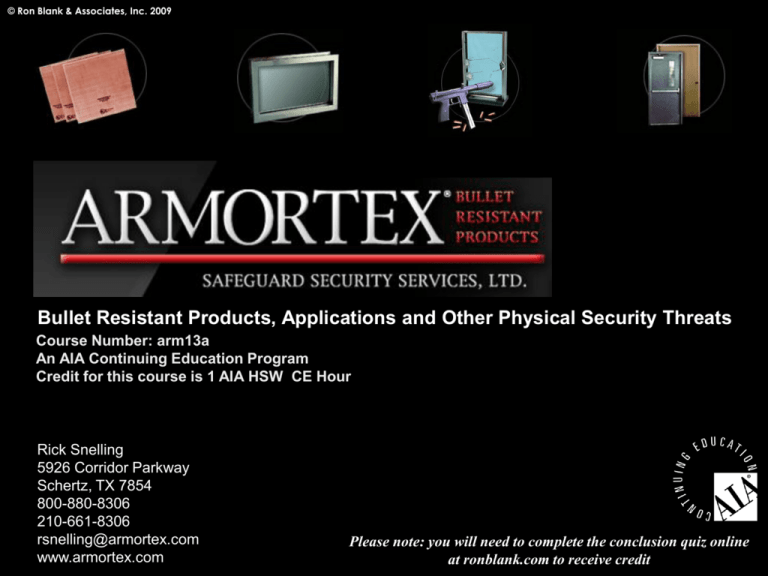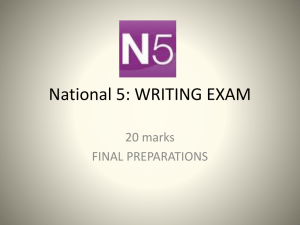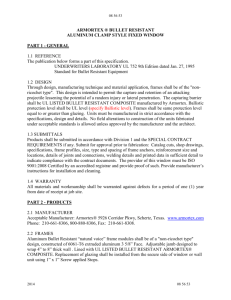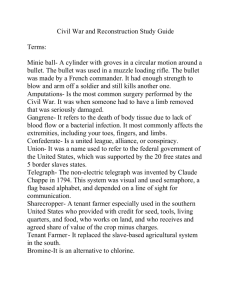Bullet Resistant Products, Applications and Other Physical Security
advertisement

© Ron Blank & Associates, Inc. 2009 Bullet Resistant Products, Applications and Other Physical Security Threats Course Number: arm13a An AIA Continuing Education Program Credit for this course is 1 AIA HSW CE Hour Rick Snelling 5926 Corridor Parkway Schertz, TX 7854 800-880-8306 210-661-8306 rsnelling@armortex.com www.armortex.com Please note: you will need to complete the conclusion quiz online at ronblank.com to receive credit An American Institute of Architects (AIA) Continuing Education Program Approved Promotional Statement: Ron Blank & Associates, Inc. is a registered provider with The American Institute of Architects Continuing Education System. Credit earned upon completion of this program will be reported to CES Records for AIA members. Certificates of Completion are available for all course participants upon completion of the course conclusion quiz with +80%. Please view the following slide for more information on Certificates of Completion through RBA This program is registered with the AIA/CES for continuing professional education. As such, it does not include content that may be deemed or construed to be an approval or endorsement by the AIA or Ron Blank & Associates, Inc. of any material of construction or any method or manner of handling, using, distributing, or dealing in any material or product. An American Institute of Architects (AIA) Continuing Education Program Course Format: This is a structured, web-based, self study course with a final exam. Course Credit: 1 AIA Health Safety & Welfare (HSW) CE Hour Completion Certificate: A confirmation is sent to you by email and you can print one upon successful completion of a course or from your RonBlank.com transcript. If you have any difficulties printing or receiving your Certificate please send requests to certificate@ronblank.com Design professionals, please remember to print or save your certificate of completion after successfully completing a course conclusion quiz. Email confirmations will be sent to the email address you have provided in your RonBlank.com account. Please note: you will need to complete the conclusion quiz online at ronblank.com to receive credit Course Description Bullet resistant products are a necessary safety precaution that protects the general public, while limiting an employer’s liability for taking adequate safety measures. This one hour online course allows the design professional to discover the need for and applications of bullet resistant products. Design professionals will develop an understanding of the levels of bullet resistance, as well as how to specify these products for a structure. We will conclude this course with a brief 10 question quiz. OBJECTIVES Upon completion of this course the Design Professional will be able to: Explain the need for bullet resistant products. List the various products and their applications. Describe the levels of bullet resistance and testing standards. Specify bullet resistant products. INTRODUCTION Need for bullet resistant products Bullet resistant products should be used anywhere there is a concern of attack with a gun. It’s another form of physical security against robberies, terrorist attacks, etc. Bullet resistant products should be used to protect against being shot or to limit an employers liability for not providing adequate protection for employees. INTRODUCTION Bullet resistant product uses Bullet resistant products are widely used in courtrooms, government and corporate offices, banks, convenience stores, gas stations, retail buildings, check cashing facilities, cashier booths, prisons, vehicles and any place where ballistic and attack resistant security is required. COURSE SECTIONS Applications Certification & testing bodies Products Typical details Case studies Conclusion 3 TYPES OF RESISTANCE: Bullet Resistant Forced Entry Designed to protect against handgun and rifle assault Designed for protection from break-in’s, riots, etc. Blast Resistant Bomb and Explosives protection APPLICATIONS TRADITIONAL APPLICATIONS Banks/Financial Institutions Police Stations Military Bases and Facilities Government Offices Federal (Customs, FBI, Secret Service…) Post Offices Training Facilities Mass Transit/Depots NON-TRADITIONAL APPLICATIONS Grocery Stores Museums Sporting Arenas Homes Retail Establishments Military Vehicles CERTIFICATIONS & TESTING CERTIFICATION & TESTING BODIES UL (Underwriters Laboratory) www.UL.com NIJ (National Institute of Justice) http://www.ojp.usdoj.gov/nij/ H.P. White www.hpwhite.com WHAT ARE THE DIFFERENCES? UL NIJ Most widely recognized bullet resistant classifying and testing organization Regular follow up testing is required for UL Listed products R&D and evaluation center for the Department of Justice No follow up testing is available. Most bullet resistant (BR) glazing products are not tested to the NIJ standards H.P. White Will test products to the manufacturers specs (may not be as stringent as UL) No follow up testing UL STANDARDS UL Firearm Ammunition Velocity ft./sec. UL – 1 (MPSA) 9mm 124 GR FMJ 1175-1295 UL STANDARDS UL Firearm Ammunition Velocity ft./sec. UL – 1 (MPSA) 9mm 124 GR FMJ 1175-1295 UL – 2 (HPSA) .357 Magnum 158 GR SP 1250-1375 UL STANDARDS UL Firearm Ammunition Velocity ft./sec. UL – 1 (MPSA) 9mm 124 GR FMJ 1175-1295 UL – 2 (HPSA) .357 Magnum 158 GR SP 1250-1375 UL – 3 (SPSA) .44 MAGNUM 240 GR LEAD 1350-1485 UL STANDARDS UL Firearm Ammunition Velocity ft./sec. UL – 1 (MPSA) 9mm 124 GR FMJ 1175-1295 UL – 2 (HPSA) .357 Magnum 158 GR SP 1250-1375 UL – 3 (SPSA) .44 MAGNUM 240 GR LEAD 1350-1485 UL – 4 (HPR) .30 cal RIFLE 180 GR SP 2540-2794 UL STANDARDS UL Firearm Ammunition Velocity ft./sec. UL – 1 (MPSA) 9mm 124 GR FMJ 1175-1295 UL – 2 (HPSA) .357 Magnum 158 GR SP 1250-1375 UL – 3 (SPSA) .44 MAGNUM 240 GR LEAD 1350-1485 UL – 4 (HPR) .30 cal RIFLE 180 GR SP 2540-2794 7.62 mm RIFLE 150 GR FMJ 2750-3025 UL - 5 UL STANDARDS UL Firearm Ammunition Velocity ft./sec. UL – 1 (MPSA) 9mm 124 GR FMJ 1175-1295 UL – 2 (HPSA) .357 Magnum 158 GR SP 1250-1375 UL – 3 (SPSA) .44 MAGNUM 240 GR LEAD 1350-1485 UL – 4 (HPR) .30 cal RIFLE 180 GR SP 2540-2794 UL - 5 7.62 mm RIFLE 150 GR FMJ 2750-3025 UL - 6 9 mm UZI 124 GR FMJ MS 1400-1540 UL STANDARDS UL Firearm Ammunition Velocity ft./sec. UL – 1 (MPSA) 9mm 124 GR FMJ 1175-1295 UL – 2 (HPSA) .357 Magnum 158 GR SP 1250-1375 UL – 3 (SPSA) .44 MAGNUM 240 GR LEAD 1350-1485 UL – 4 (HPR) .30 cal RIFLE 180 GR SP 2540-2794 UL - 5 7.62 mm RIFLE 150 GR FMJ 2750-3025 UL - 6 9 mm UZI 124 GR FMJ MS 1400-1540 UL - 7 5.56 mm M-16 55 GR FMJ MS 3080-3388 UL STANDARDS UL Firearm Ammunition Velocity ft./sec. UL – 1 (MPSA) 9mm 124 GR FMJ 1175-1295 UL – 2 (HPSA) .357 Magnum 158 GR SP 1250-1375 UL – 3 (SPSA) .44 MAGNUM 240 GR LEAD 1350-1485 UL – 4 (HPR) .30 cal RIFLE 180 GR SP 2540-2794 UL - 5 7.62 mm RIFLE 150 GR FMJ 2750-3025 UL - 6 9 mm UZI 124 GR FMJ MS 1400-1540 UL - 7 5.56 mm M-16 55 GR FMJ MS 3080-3388 UL - 8 7.62 mm M-14 150 GR FMJ MS 2750-3025 UL STANDARDS UL Firearm Ammunition Velocity ft./sec. UL – 1 (MPSA) 9mm 124 GR FMJ 1175-1295 UL – 2 (HPSA) .357 Magnum 158 GR SP 1250-1375 UL – 3 (SPSA) .44 MAGNUM 240 GR LEAD 1350-1485 UL – 4 (HPR) .30 cal RIFLE 180 GR SP 2540-2794 UL - 5 7.62 mm RIFLE 150 GR FMJ 2750-3025 UL - 6 9 mm UZI 124 GR FMJ MS 1400-1540 UL - 7 5.56 mm M-16 55 GR FMJ MS 3080-3388 UL - 8 7.62 mm M-14 150 GR FMJ MS 2750-3025 SPECIFYING BULLET RESISTANT PRODUCTS Determine desired bullet resistant (BR) level. Note: All BR products should have the same protection level (i.e: doors, windows and fiberglass should all be Level 4) BR protection specifications should be specified in Section 13070 of the CSI Master Format SPECIFYING BR PRODUCTS con’t Contact a BR manufacturer for guidance concerning specifications and request a technical binder if available For your own security you should require Product Liability Insurance from the manufacturer PRODUCTS STANDARD ANTI BALLISTIC PRODUCTS Fiberglass Panels Glazing Transaction & Fixed Windows Wood, Hollow Metal & Aluminum Storefronts & Doors Package Receivers Transaction Drawers & Dip Trays Speakers & Gun Ports PRODUCTS FIBERGLASS PANELS FIBERGLASS PANELS Typically specified to be installed behind drywall, millwork (i.e.; judges benches) or in vehicles. Also used as a protective barrier in doors, window frames, package receivers, etc. Woven Roving Ballistic Grade Fiberglass Multiple Ply Opaque Fiber Rigid Plys Delaminate On Impact From Projectile LEVEL 1 UL Listed Level 1 2.0 lbs. SF nominal weight 3/16” nominal thickness 9 mm LEVEL 2 UL Listed Level 2 3.0 lbs. SF nominal weight 5/16” nominal thickness .357 Magnum and 9 mm UZI (multiple shots) LEVEL 3 UL Listed Level 3 4.0 lbs. SF nominal weight 7/16” nominal thickness .44 Magnum LEVEL 4 UL Listed Level 4 12.0 lbs. SF nominal weight 1 3/16” nominal thickness .30 cal. rifle (single shot) LEVEL 5 UL Listed Level 5 13.0 lbs. SF nominal weight 1 3/16” nominal thickness 7.62 mm (single shot) LEVEL 6 UL Listed Level 6 3.0 lbs. SF nominal weight 5/16” nominal thickness 9 mm UZI (multiple shots) LEVEL 7 UL Listed Level 7 12.0 lbs. SF nominal weight 1 3/16” nominal thickness 5.56 mm M-16 (multiple shots) LEVEL 8 UL Listed Level 8 14.0 lbs. SF nominal weight 1 5/16” nominal thickness 7.62 mm M-14 (multiple shots) TYPICAL WALL ASSEMBLY INSTALLATION DIRECTIONS NOTES: 1.BULLET RESISTANT PANEL 2.BATTEN STRIP (CUT FROM FIBERGLASS FULL SHEET) 3.DRY WALL PANEL (BY OTHERS) 4.STEEL OR WOOD STUDS (BY OTHERS) NOTE: JOINTS BETWEEN FIBERGLASS PANELS MUST BE KEPT AS TIGHT AS POSSIBLE. STANDARD PANEL SIZES PRODUCTS GLAZING GLAZING Bullet Resistant Laminated Glass (BRG) UL Levels 1, 2, 3 & 4 Glass Clad Polycarbonate (GCP) UL Levels 1thru 8 plus Armor Piercing Polycarbonate & Acrylic UL Levels 1 thru 3 PRO’S and CON’S of each type of glazing: Bullet Resistant Laminated Glass (BRG) Glass Clad Polycarbonate (GCP) scratch resistant (2 exposed glass surfaces) but heavy, thick and with a noticeable greenish tint lighter, thinner and without the greenish tint of BRG, slightly more expensive with 1 plastic surface Glass Poly Glass (GPG) (not UL Listed because of spalling) well suited for full light doors since it is scratch resistant and does not have a tendency to warp PRO’S and CON’S of each type of glazing: Polycarbonate Lightest in weight, clearest, though most expensive and has 2 plastic surfaces. Most easily vandalized or to show wear and tear. Acrylic the most clear of all the glazing types but it’s thick and will not protect above Level 3. Unless hard coated, it is susceptible to scratching. Often used in banks (without frames) due to it’s crystal clear appearance. PRODUCTS WINDOWS Protection levels 1 thru 8 plus Armor Piercing TRANSACTION WINDOWS Transaction Windows are typically used in banks, ticket offices, government offices or anywhere where (cash, documents) are exchanged from one side of the window to the other. The configurations are limitless. A transaction window can be fabricated with any frame style, any type of glazing or any dimension required to suite your design. TRANSACTION WINDOWS 4 frame types Aluminum (prime painted and clamp) ”C” Channel Hollow Metal (prime painted and stainless steel) Various glazing options Laminated Glass Glass Clad Poly Glass Poly Glass Polycarbonate TYPICAL TRANSACTION WINDOW with Dip Tray and Counter TRANSACTION DRAWER & FIXED WINDOW Typical application for a sliding transaction window would be a reception area in a clinic. SLIDING TRANSACTION WINDOW Typical application for a sliding transaction window would be a reception area in a clinic or in a police station lobby. Define each type how are they used or not used? FIXED WINDOWS 3 frame types Aluminum Primed Steel Stainless Steel Clamp, Split or Conventional Various glazing options Laminated Glass Glass Clad Poly Polycarbonate Glass Poly Glass FIXED WINDOWS Fixed windows are typically used for observation purposes PRODUCTS DOORS Protection levels 1 thru 8 plus Armor Piercing WOOD & HOLLOW METAL DOOR STYLES These door styles apply to both Wood and Hollow Metal Doors. NL = No Lite (no glass in the door) | VL = Vision Lite | SL = Slim Lite DOOR STYLES con’t These door styles apply to both Wood and Hollow Metal Doors. HL = Half Lite| DL = Double Lite| FL = Full Lite WOOD DOORS Pre-hung on one-piece welded hollow metal frame with heavy duty continuous gear hinge Split frames are available Choice of veneers and laminates Fiberglass core for Levels 1thru 8 Various glazing options are available HOLLOW METAL DOORS Pre-hung on one-piece welded hollow metal frame with heavy duty continuous gear hinge Split frames are available Fiberglass core for Levels 1, 2, 3 & 6 Ballistic Steel for Levels 4, 5, 7, 8 & Armor Piercing Various glazing options are available ALUMINUM DOORS Complete Storefront Systems Protection Levels 1-8 PRODUCTS MISCELLANEOUS EQUIPMENT PACKAGE RECEIVERS Typical application is for transferring packages, boxes, containers, etc. from one side of a secure wall to the other Primed Steel body w/ Primed Steel or Stainless Steel doors Standard sizes 18 x 18 24 x 24 Transparent Package Receivers Polycarbonate Acrylic TRANSACTION DRAWERS & TRAYS Drawers Dip Trays (“Transaction Drawers” and “Dip Trays” are available and widely used with Transaction Windows) SPEAKERS & GUN PORTS Speakers are used to provide better voice transmission with Transaction Windows Gun Ports offer security personnel the ability to fire a gun while protected behind a bullet resistant barrier Pivot Gun Port Window mounted Sliding Gun Port Wall mounted Detention/Security Speaker Bullet Resistant Speaker CUSTOM PRODUCTS Operable Windows (hinged on the side like a door) Postal Package Receivers (Package Receivers specifically designed and approved by the US Post Office) Bank Drive Thru Windows (drive up windows with transaction drawers which are extendable to a vehicle) Pistol Lockers (metal lockers for securing firearms, often used in police stations) Miscellaneous OTHER APPLICATIONS TO CONSIDER IN OTHER PROJECTS Weather Protection Hurricanes Tornadoes Vehicle Protection Military Armored Cars (money couriers, private individuals) CASE STUDIES STUDY 1 A high profile wholesale jeweler in Manhattan wanted to upgrade the physical security in their corporate office. Level 3 bullet resistant double full lite wood doors were installed as well as a transaction window, package receiver and non-ricochet fiberglass panels in the walls surrounding the window, doors and package receiver. STUDY 2 Recognizing the increased security threat, a U.S. Customs office located at an international airport upgraded the ballistic protection from Level 3 (.44 Magnum) to Level 8 (multiple shots from a 7.62MM rifle). A hollow metal door and fiberglass panels were installed at the front entrance to accomplish this security enhancement. CONCLUSION With the current state of affairs around the world, physical security needs are increasingly important. If you are involved in the designing and/or specifying of security projects it is imperative that you understand Bullet Resistant products and their proper applications. OBJECTIVES The Design Professional will now be able to: Explain the need for bullet resistant products. List the various products and their applications. Describe the levels of bullet resistance & testing standards. Specify bullet resistant products. © Ron Blank & Associates, Inc. 2009 Bullet Resistant Products, Applications and Other Physical Security Threats Course Number: arm13a An AIA Continuing Education Program Credit for this course is 1 AIA HSW CE Hour Rick Snelling 5926 Corridor Parkway Schertz, TX 7854 800-880-8306 210-661-8306 rsnelling@armortex.com www.armortex.com Please note: you will need to complete the conclusion quiz online at ronblank.com to receive credit






